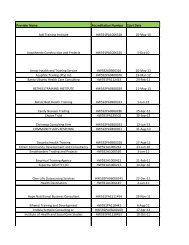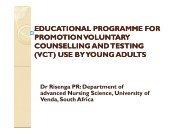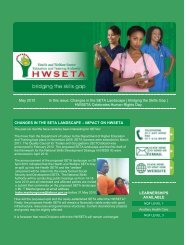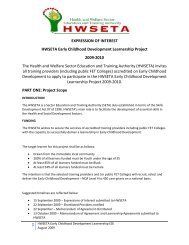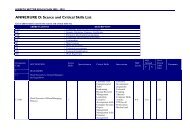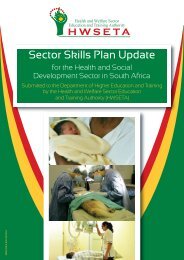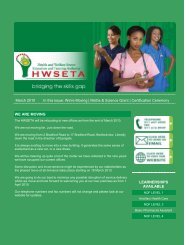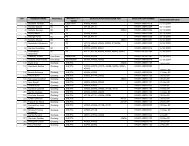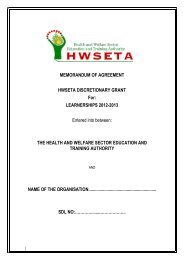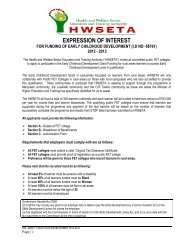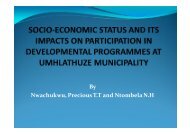sector skills plan for the health sector in south africa
sector skills plan for the health sector in south africa
sector skills plan for the health sector in south africa
Create successful ePaper yourself
Turn your PDF publications into a flip-book with our unique Google optimized e-Paper software.
actively recruit<strong>in</strong>g to fill all <strong>the</strong>se posts. Thus <strong>the</strong> <strong>in</strong><strong>for</strong>mation on vacant posts on PERSAL must be used<br />
with caution as it does not reflect <strong>the</strong> true state of vacant posts <strong>in</strong> <strong>the</strong> public <strong>sector</strong>. .<br />
Table 4-3 Vacancy rates <strong>in</strong> <strong>the</strong> National and prov<strong>in</strong>cial <strong>health</strong> departments <strong>in</strong> selected occupation: 31<br />
March 2010<br />
Occupation Vacant Filled Total Vacancy Rate (%)<br />
Dental practitioners 921 770 1 691 54<br />
Dental specialists 155 121 276 56<br />
Medical practitioners 10 860 11 302 22 162 49<br />
Medical specialists 3 491 4 436 7 927 44<br />
Professional nurses 44 780 51 964 96 744 46<br />
Staff and pupil nurses 16 202 24 315 40 517 40<br />
Student nurses 2 458 10 906 13 364 18<br />
Pharmacists 3 745 2 958 6 703 56<br />
Physio<strong>the</strong>rapists 1 074 1 009 2 083 52<br />
Occupational <strong>the</strong>rapists 1 260 838 2 098 60<br />
Radiographists 1 621 2 300 3 921 41<br />
Psychologists 699 498 1 197 58<br />
Source: PERSAL.<br />
Skills shortages or scarce <strong>skills</strong> are also monitored by <strong>the</strong> SETAs <strong>in</strong> <strong>the</strong> WSPs submitted to <strong>the</strong>m on an<br />
annual basis. For <strong>the</strong> purposes of this SSP <strong>the</strong> WSPs submitted to <strong>the</strong> HWSETA and those submitted by<br />
<strong>the</strong> <strong>health</strong> departments to <strong>the</strong> PSETA were comb<strong>in</strong>ed to provide an overview of <strong>the</strong> shortages<br />
experienced <strong>in</strong> <strong>the</strong> <strong>health</strong> <strong>sector</strong>. However, <strong>the</strong> two SETAs didn’t <strong>for</strong>mulate <strong>the</strong>ir questions identically,<br />
and, <strong>the</strong>re<strong>for</strong>e, <strong>the</strong> figures are not directly comparable. Table 4-4 comb<strong>in</strong>es <strong>the</strong> <strong>in</strong><strong>for</strong>mation <strong>for</strong> <strong>the</strong><br />
private <strong>sector</strong> and <strong>the</strong> Public Service. In this table only occupations <strong>in</strong> which more than 75 vacancies<br />
existed are reported. The occupations are grouped toge<strong>the</strong>r <strong>in</strong> professional fields such as nurs<strong>in</strong>g and<br />
pharmacy. A more detailed list of scarce <strong>skills</strong> accord<strong>in</strong>g to <strong>the</strong> OFO is attached <strong>in</strong> Appendix A.<br />
In 2010, 33% of <strong>the</strong> organisations that submitted WSPs to <strong>the</strong> HWSETA reported difficulties <strong>in</strong> fill<strong>in</strong>g<br />
certa<strong>in</strong> vacancies, while <strong>the</strong> national DoH as well as most of <strong>the</strong> prov<strong>in</strong>cial departments 157 reported skill<br />
shortages. In <strong>the</strong> private <strong>health</strong> <strong>sector</strong>, a total of 4 184 vacancies (3% of total employment) were<br />
difficult to fill and <strong>in</strong> <strong>the</strong> public <strong>health</strong> <strong>sector</strong> 26 441 people (13% of total employment) were required to<br />
meet scarce <strong>skills</strong> needs. A third of <strong>the</strong> vacancies that were difficult to fill <strong>in</strong> private <strong>health</strong> organisations<br />
were vacancies <strong>for</strong> professional positions, while 47% of <strong>the</strong> scarce <strong>skills</strong> reported <strong>in</strong> <strong>the</strong> Public Service<br />
were <strong>for</strong> professionals such as medical specialists and practitioners, registered nurses and pharmacists<br />
(Table 4-4). The public <strong>health</strong> <strong>sector</strong> <strong>in</strong>dicated severe shortages of f<strong>in</strong>ancial managers and managers <strong>in</strong><br />
<strong>in</strong><strong>for</strong>mation technology, while a need <strong>for</strong> more <strong>health</strong>-related professionals such as dieticians and<br />
physio<strong>the</strong>rapists also existed.<br />
157 Scarce <strong>skills</strong> <strong>in</strong><strong>for</strong>mation could not be obta<strong>in</strong>ed from <strong>the</strong> Mpumalanga department of <strong>health</strong><br />
46



